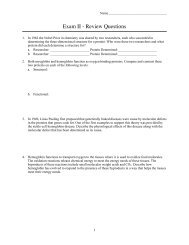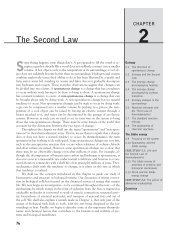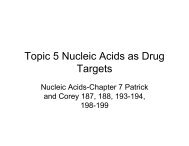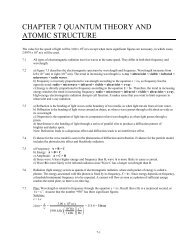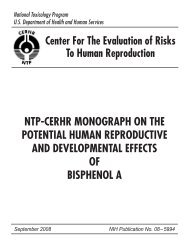ACS Paragon Plus Environment Submitted to Journal of the ...
ACS Paragon Plus Environment Submitted to Journal of the ...
ACS Paragon Plus Environment Submitted to Journal of the ...
Create successful ePaper yourself
Turn your PDF publications into a flip-book with our unique Google optimized e-Paper software.
<strong>Submitted</strong> <strong>to</strong> <strong>Journal</strong> <strong>of</strong> <strong>the</strong> American Chemical Society<br />
NMR, Mass Spectrometry and Chemical Evidence Reveal a Different<br />
Chemical Structure for Methanobactin That Contains Oxazolone Rings<br />
<strong>Journal</strong>: <strong>Journal</strong> <strong>of</strong> <strong>the</strong> American Chemical Society<br />
Manuscript ID: ja-2008-04747d<br />
Manuscript Type: Communication<br />
Date <strong>Submitted</strong> by <strong>the</strong><br />
Author: 20-Jun-2008<br />
Complete List <strong>of</strong> Authors: Behling, Lee; University <strong>of</strong> Wisconsin-Eau Claire, Chemistry<br />
Hartsel, Scott; University <strong>of</strong> Wisconsin-Eau Claire, Chemistry<br />
Lewis, David; University <strong>of</strong> Wisconsin-Eau Claire, Chemistry<br />
DiSpiri<strong>to</strong>, Alan; Iowa State University, Department <strong>of</strong> Biochemistry,<br />
Biophysics and Molecular Biology<br />
Choi, Dong; Iowa State University, Biochemistry, Biophysics and<br />
Molecular Biology<br />
Masterson, Larry; University <strong>of</strong> Minnesota, Biochemistry, Molecular<br />
Biology and Biophysics<br />
Veglia, Gianluigi; University <strong>of</strong> Minnesota, Department <strong>of</strong> Chemistry<br />
Gallagher, Warren; University <strong>of</strong> Wisconsin-Eau Claire, Chemistry<br />
<strong>ACS</strong> <strong>Paragon</strong> <strong>Plus</strong> <strong>Environment</strong>
Page 1 <strong>of</strong> 3<br />
1<br />
2<br />
3<br />
4<br />
5<br />
6<br />
7<br />
8<br />
9<br />
10<br />
11<br />
12<br />
13<br />
14<br />
15<br />
16<br />
17<br />
18<br />
19<br />
20<br />
21<br />
22<br />
23<br />
24<br />
25<br />
26<br />
27<br />
28<br />
29<br />
30<br />
31<br />
32<br />
33<br />
34<br />
35<br />
36<br />
37<br />
38<br />
39<br />
40<br />
41<br />
42<br />
43<br />
44<br />
45<br />
46<br />
47<br />
48<br />
49<br />
50<br />
51<br />
52<br />
53<br />
54<br />
55<br />
56<br />
57<br />
58<br />
59<br />
60<br />
<strong>Submitted</strong> <strong>to</strong> <strong>Journal</strong> <strong>of</strong> <strong>the</strong> American Chemical Society<br />
NMR, Mass Spectrometry and Chemical Evidence Reveal a Different Chemical Structure<br />
for Methanobactin That Contains Oxazolone Rings<br />
Lee A. Behling, † Scott C. Hartsel, † David E. Lewis, † Alan A. DiSpiri<strong>to</strong>, ‡ Dong W. Choi, ‡ Larry R.<br />
Masterson, § Gianluigi Veglia, §,� and Warren H. Gallagher *,†<br />
Chemistry Department, University <strong>of</strong> Wisconsin-Eau Claire, Eau Claire, Wisconsin, 54702, Department <strong>of</strong><br />
Biochemistry, Biophysics and Molecular Biology, Iowa State University, Ames, Iowa, 50011, Department <strong>of</strong><br />
Chemistry and Department <strong>of</strong> Biochemistry, Molecular Biology and Biophysics, University <strong>of</strong> Minnesota-Twin<br />
Cities, Minneapolis, Minnesota, 55455<br />
RECEIVED DATE (au<strong>to</strong>matically inserted by publisher); E-mail: wgallagh@uwec.edu<br />
Methanobactin (mb) is a small, copper binding peptide<br />
produced by methanotrophic bacteria that use methane as <strong>the</strong>ir<br />
primary source <strong>of</strong> energy and play an integral role in <strong>the</strong><br />
global carbon cycle. Mb can be isolated from <strong>the</strong> growth<br />
media <strong>of</strong> methanotrophs 1,2,3 and is also found within <strong>the</strong><br />
bacterial cells and associated with <strong>the</strong> copper and iron<br />
containing methane mono-oxygenase (pMMO). 4,5 pMMO,<br />
along with its soluble form (sMMO) produced under limiting<br />
copper levels, is responsible for catalyzing <strong>the</strong> oxidation <strong>of</strong><br />
methane <strong>to</strong> methanol. Thus, this enzyme has received much<br />
attention for its role in removing a potent greenhouse gas from<br />
<strong>the</strong> atmosphere, and for <strong>the</strong> development <strong>of</strong> new<br />
hydroxylation catalysts that could make more efficient use <strong>of</strong><br />
natural gas. 6<br />
Mb is involved in many biological processes, including<br />
scavenging copper from <strong>the</strong> environment, 1,7,8 serving as a<br />
copper chaperone for pMMO, 1,4,7 complexing reactive oxygen<br />
species, 4,9 and mediating both electron flow <strong>to</strong> pMMO 3,4,9 and<br />
<strong>the</strong> genetic expression <strong>of</strong> pMMO. 1,10 Copper-free mb can be<br />
isolated under low copper levels. 3 It binds Cu(II) with<br />
nanomolar affinity, reducing it <strong>to</strong> Cu(I). 3,11,13 In addition, mb<br />
can bind Cd(II), Co(II), Fe(III), Mn(II), Ni(II), Zn(II), and can<br />
bind and reduce Ag(I), Au(III), Hg(II), Pb(II). 14<br />
The best characterized mb peptide is isolated from<br />
Methylosinus trichosporium OB3b. 2,11 It contains seven amino<br />
acids and two unusual chromophoric residues, each containing<br />
a thiocarbonyl/enethiol attached <strong>to</strong> a conjugated ring system.<br />
Through a combination <strong>of</strong> mass spectrometry and X-ray<br />
crystallography, <strong>the</strong>se ring systems were assigned as<br />
hydroxyimidazolates (Figure S1), which were ligated <strong>to</strong> Cu(I)<br />
in an N2S2 dis<strong>to</strong>rted tetrahedral geometry. 2,11,12 However, it<br />
has been very difficult <strong>to</strong> reconcile <strong>the</strong> chemical composition<br />
<strong>of</strong> <strong>the</strong>se residues with possible biosyn<strong>the</strong>tic pathways that<br />
bacteria use <strong>to</strong> produce mb. Since <strong>the</strong>se residues directly<br />
participate in metal ion binding and are likely <strong>to</strong> be involved<br />
in many o<strong>the</strong>r chemical activities displayed by mb, 9 it is<br />
crucial <strong>to</strong> establish <strong>the</strong>ir correct chemical structures.<br />
In this communication, we report a revised structure <strong>of</strong> mb,<br />
which reconciles chemical analysis, NMR, X-ray, and mass<br />
spectrometry data with possible biosyn<strong>the</strong>tic pathways for<br />
expression <strong>of</strong> mb in bacteria. The revised structure also clears<br />
up confusion in <strong>the</strong> literature 2,7,11,13 on reporting both <strong>the</strong><br />
chemical structure and <strong>the</strong> chemical formula for mb.<br />
We isolated mb as described by Choi et al. 3 and incubated it<br />
†University <strong>of</strong> Wisconsin-Eau Claire<br />
‡Iowa State University<br />
§University <strong>of</strong> Minnesota, Department <strong>of</strong> Biochemistry, Molecular Biology and<br />
Biophysics<br />
�University <strong>of</strong> Minnesota, Department <strong>of</strong> Chemistry<br />
<strong>ACS</strong> <strong>Paragon</strong> <strong>Plus</strong> <strong>Environment</strong><br />
with between 0.5 and 1.0 Cu(II) ions per mb <strong>to</strong> obtain <strong>the</strong><br />
Cu(I)-bound form. We purified <strong>the</strong> Cu(I)-bound mb by HPLC,<br />
and after lyophilization, re-dissolved <strong>the</strong> peptide in ei<strong>the</strong>r<br />
100% D2O or 10% D2O containing 9 mM sodium phosphate<br />
(pH 6.5) for NMR analysis (see Supporting Information). We<br />
collected <strong>the</strong> NMR spectra at 400 MHz or 600 MHz at ei<strong>the</strong>r 5<br />
°C or 25 °C. We used a combination <strong>of</strong> [ 1 H, 1 H]-COSY,<br />
Figure 1. The proposed structure for methanobactin; 1-(N-<br />
[mercap<strong>to</strong>-{5-oxo-2-(3-methylbutanoyl)oxazol-4-ylidene}methyl]-<br />
Gly 1 -Ser 2 -Cys 3 -Tyr 4 )-pyrrolidin-2-yl-(mercap<strong>to</strong>-[5-oxo-oxazol-4ylidene]methyl)-Ser<br />
5 -Cys 6 -Met 7 . The model shown is <strong>the</strong><br />
(M-2H+ 63 Cu) 1- charged species. The backbone is traced in blue.<br />
Figure 2. 600 MHz spectra <strong>of</strong> methanobactin in 9 mM<br />
phosphate/10% D2O, pH6.5, 25°C. The sample was exposed <strong>to</strong> Cu(II)<br />
at 0.55 Cu:mb prior <strong>to</strong> isolation by HPLC. Selected regions <strong>of</strong> NMR<br />
spectra are shown indicating <strong>the</strong> presence <strong>of</strong> a 3-methylbutanoyl<br />
group. Connectivities and chemical shifts from A) [ 1 H, 1 H]-TOCSY<br />
and B) [ 1 H, 13 C]-HMBC spectra indicate an A3B3MXY type spin<br />
system (ie, CH3(CH3)CHCH2–). Additional multiple bond<br />
connectivity from [ 1 H, 13 C]-HMBC spectra in C) and D) confirm<br />
attachment <strong>of</strong> a carbonyl group <strong>to</strong> this moiety.
1<br />
2<br />
3<br />
4<br />
5<br />
6<br />
7<br />
8<br />
9<br />
10<br />
11<br />
12<br />
13<br />
14<br />
15<br />
16<br />
17<br />
18<br />
19<br />
20<br />
21<br />
22<br />
23<br />
24<br />
25<br />
26<br />
27<br />
28<br />
29<br />
30<br />
31<br />
32<br />
33<br />
34<br />
35<br />
36<br />
37<br />
38<br />
39<br />
40<br />
41<br />
42<br />
43<br />
44<br />
45<br />
46<br />
47<br />
48<br />
49<br />
50<br />
51<br />
52<br />
53<br />
54<br />
55<br />
56<br />
57<br />
58<br />
59<br />
60<br />
<strong>Submitted</strong> <strong>to</strong> <strong>Journal</strong> <strong>of</strong> <strong>the</strong> American Chemical Society<br />
[ 1 H, 1 H]-TOCSY, [ 1 H, 1 H]-ROESY, [ 1 H, 15 N]-HSQC, [ 1 H, 13 C]-<br />
HSQC, and [ 1 H, 13 C]-HMBC experiments <strong>to</strong> assign all <strong>of</strong> <strong>the</strong><br />
non-hydroxyl 1 H and 15 N resonances, along with all <strong>of</strong> <strong>the</strong> 13 C<br />
resonances except for <strong>the</strong> ones belonging <strong>to</strong> <strong>the</strong> conjugated<br />
rings (Table S1). While <strong>the</strong> sequential 1 H and 13 C assignments<br />
are consistent with <strong>the</strong> seven amino acid residues in <strong>the</strong><br />
published structure (Figure S1), those for <strong>the</strong> N-terminal<br />
chromophoric residue are not. As shown in Figure 2, <strong>the</strong> spin<br />
system observed in [ 1 H, 1 H]-TOCSY spectra for <strong>the</strong> N-terminal<br />
alkyl group is consistent with an isobutyl group ra<strong>the</strong>r than <strong>the</strong><br />
previously proposed isopropyl group. The [ 1 H, 13 C]-HMBC<br />
experiment confirmed that this isobutyl moiety is attached <strong>to</strong> a<br />
carbonyl <strong>to</strong> form a 3-methylbutanoyl group.<br />
For a full characterization <strong>of</strong> <strong>the</strong> nitrogen content <strong>of</strong> <strong>the</strong><br />
peptide, we used 15 N direct detection on a uniformly 15 Nlabeled<br />
sample <strong>of</strong> Cu(I)-bound mb. Figure 3 shows <strong>the</strong> 1D<br />
pro<strong>to</strong>n decoupled 15 N spectrum. Indeed, we observed only ten<br />
15 N resonances with nearly equal intensities. This confutes <strong>the</strong><br />
previous structure with hydroxyimidazolates rings, which<br />
should display a <strong>to</strong>tal <strong>of</strong> twelve nitrogen resonances. Eight<br />
nitrogen resonances are attached <strong>to</strong> pro<strong>to</strong>ns and were assigned<br />
using an [ 1 H, 15 N]-HSQC experiment (Figure S2). The<br />
remaining two nitrogen resonances at 226 and 249 ppm show<br />
no pro<strong>to</strong>n coupling and require long cycle times (>10 s) <strong>to</strong> be<br />
observed, suggesting long longitudinal spin relaxation times<br />
(T1). Guided by <strong>the</strong> X-ray structure, we assigned <strong>the</strong>se<br />
resonances <strong>to</strong> nitrogens belonging <strong>to</strong> two oxazolone rings and<br />
not hydroxyimidazolates rings.<br />
To confirm <strong>the</strong> mass <strong>of</strong> <strong>the</strong> peptide, we carried out ESI-<br />
TOF mass spectrometry on Cu(I)-bound mb. In agreement<br />
with previous data, 2,11,13 we observe an m/z <strong>of</strong> 1215 for <strong>the</strong><br />
(M-2H+ 63 Cu) 1- species. The presence <strong>of</strong> a 3-methylbutanoyl<br />
group instead <strong>of</strong> an isopropyl ester would result in a<br />
<strong>the</strong>oretical m/z <strong>of</strong> 1213. However, <strong>the</strong> inclusion <strong>of</strong> <strong>the</strong> two<br />
alkylidene oxazolone rings (instead <strong>of</strong> <strong>the</strong> originally proposed<br />
hydroxyimidazolate rings) results in an expected m/z <strong>of</strong> 1215,<br />
which agrees well with our measurements. We repeated <strong>the</strong><br />
mass spectrometry analysis multiple times, obtaining values<br />
for m/z that are within ±1.2 ppm <strong>of</strong> that expected for our<br />
proposed structure (1215.1781), but lying 8 <strong>to</strong> 10 ppm below<br />
that expected for <strong>the</strong> previously published structure 11<br />
Figure 3. The pro<strong>to</strong>n-decoupled,<br />
(1215.1893) (Figure S3a).<br />
The presence <strong>of</strong> oxazolone rings was also substantiated by<br />
chemical degradation <strong>of</strong> uncomplexed mb using methanolysis.<br />
Oxazolone rings contain a lac<strong>to</strong>ne that is susceptible <strong>to</strong><br />
15 N spectrum <strong>of</strong> U- 15 N Cu(I)bound<br />
methanobactin at 25°C. A <strong>to</strong>tal <strong>of</strong> ten resonances are observed<br />
with <strong>the</strong> relative integrated intensities for each indicated.<br />
<strong>ACS</strong> <strong>Paragon</strong> <strong>Plus</strong> <strong>Environment</strong><br />
methanolysis 15 and <strong>the</strong> concomitant loss <strong>of</strong> <strong>the</strong> conjugated<br />
ring systems can be followed by UV/Vis spectropho<strong>to</strong>metry. 8<br />
Interestingly, <strong>the</strong> oxazolone B ring is more susceptible <strong>to</strong><br />
methanolysis than <strong>the</strong> A ring (Figure S4). 8 As expected for <strong>the</strong><br />
methanolysis <strong>of</strong> oxazolone rings, <strong>the</strong> mass <strong>of</strong> <strong>the</strong> product<br />
formed upon methanolysis <strong>of</strong> <strong>the</strong> oxazolone B ring<br />
corresponds <strong>to</strong> an increase <strong>of</strong> one equivalent <strong>of</strong> methanol<br />
(Figure S5). The opening <strong>of</strong> <strong>the</strong> oxazolone A ring requires<br />
higher concentrations <strong>of</strong> methanolic-HCl (0.01 vs. 0.001<br />
saturated methanolic-HCl) and results in an increase <strong>of</strong> <strong>the</strong><br />
mass <strong>of</strong> <strong>the</strong> product by a second equivalent <strong>of</strong> methanol<br />
(Figure S5).<br />
In summary, NMR, mass spectrometry and chemical<br />
degradation all point <strong>to</strong> a primary structure for mb containing<br />
two alkylidene oxazolone rings ra<strong>the</strong>r than <strong>the</strong> previously<br />
published hydroxyimidazolate rings. This new proposed mb<br />
structure also suggests possible pathways for <strong>the</strong> biosyn<strong>the</strong>sis<br />
<strong>of</strong> mb from common amino acids. A scheme illustrating how<br />
mb could be syn<strong>the</strong>sized by modifications <strong>of</strong> a peptide<br />
(LSGSCYPSSCM) is reported in <strong>the</strong> Supporting Information<br />
(Scheme S1). There are two proposed pathways. One is<br />
consistent with <strong>the</strong> fact that oxazolones have long been used<br />
as intermediates in <strong>the</strong> chemical syn<strong>the</strong>ses <strong>of</strong> amino acids. 15<br />
The o<strong>the</strong>r is consistent with numerous examples <strong>of</strong> bacterially<br />
produced bactin and siderophore peptides containing <strong>the</strong><br />
related oxazoline ring. 16<br />
Acknowledgement. This work was supported by an RSEC grant<br />
from <strong>the</strong> Chemistry Department, University <strong>of</strong> Minnesota (L.A.B and<br />
W.H.G), and by internal grants from ORSP, University <strong>of</strong> Wisconsin-<br />
Eau Claire (L.A.B and W.H.G). The 400 MHz Bruker Avance II<br />
NMR spectrometer and <strong>the</strong> Agilent 6210 ESI-TOF LC/MS used in<br />
<strong>the</strong>se studies were funded with NSF grants (CHE-0521019 and CHE-<br />
0619296) <strong>to</strong> <strong>the</strong> UW-Eau Claire. NSF funding (BIR-961477) was<br />
also provided <strong>to</strong> <strong>the</strong> University <strong>of</strong> Minnesota NMR Facility.<br />
Supporting Information Available: Experimental procedures, 1 H,<br />
13 15 1 15 13<br />
C and N resonance assignments; additional H, N, C NMR and<br />
mass spectra; <strong>the</strong> methanolysis data, proposed schemes for <strong>the</strong><br />
biosyn<strong>the</strong>sis <strong>of</strong> mb; complete references for citations 8, 9 and 14.<br />
This material is available free <strong>of</strong> charge via <strong>the</strong> Internet at<br />
http://pubs.acs.org.<br />
References<br />
(1) DiSpiri<strong>to</strong>, A. A.; Zahn, J. A.; Graham, D. W.; Kim, H. J.; Larive, C. K.;<br />
Derrick, T. S.; Cox, C. D.; Taylor, A. J Bacteriol 1998, 180, 3606-13.<br />
(2) Kim, H. J.; Galeva, N.; Larive, C. K.; Alterman, M.; Graham, D. W.<br />
Biochemistry 2005, 44, 5140-8.<br />
(3) Choi, D. W.; Antholine, W. E.; Do, Y. S.; Semrau, J. D.; Kisting, C. J.;<br />
Kunz, R. C.; Campbell, D.; Rao, V.; Hartsel, S. C.; DiSpiri<strong>to</strong>, A. A.<br />
Microbiology 2005, 151, 3417-26.<br />
(4) Choi, D. W.; Kunz, R. C.; Boyd, E. S.; Semrau, J. D.; Antholine, W. E.;<br />
Han, J. I.; Zahn, J. A.; Boyd, J. M.; de la Mora, A. M.; DiSpiri<strong>to</strong>, A. A. J<br />
Bacteriol 2003, 185, 5755-64.<br />
(5) Martinho, M.; Choi, D. W.; Dispiri<strong>to</strong>, A. A.; Antholine, W. E.; Semrau,<br />
J. D.; Munck, E. J Am Chem Soc 2007, 129, 15783-5.<br />
(6) Lieberman, R. L.; Rosenzweig, A. C. Nature 2005, 434, 177-82.<br />
(7) Balasubramanian, R.; Rosenzweig, A. C. Curr Opin Chem Biol 2008, 12,<br />
245-249.<br />
(8) Choi, D. W et al. Biochemistry 2006, 45, 1442-53.<br />
(9) Choi, D. W. et al. J Inorg Biochem 2008, doi:10.1016/j.jinorgbio.2008<br />
.02.003.<br />
(10) Knapp, C. W.; Fowle, D. A.; Kulczycki, E.; Roberts, J. A.; Graham, D.<br />
W. Proc Natl Acad Sci U S A 2007, 104, 12040-5.<br />
(11) Kim, H. J.; Graham, D. W.; DiSpiri<strong>to</strong>, A. A.; Alterman, M. A.; Galeva,<br />
N.; Larive, C. K.; Asunskis, D.; Sherwood, P. M. Science 2004, 305,<br />
1612-5.<br />
(12) Kim, H. J. Ph.D. Thesis, University <strong>of</strong> Kansas 2003.<br />
(13) Hakemian, A. S.; Tinberg, C. E.; Kondapalli, K. C.; Telser, J.; H<strong>of</strong>fman,<br />
B. M.; Stemmler, T. L.; Rosenzweig, A. C. J Am Chem Soc 2005, 127,<br />
17142-3.<br />
(14) Choi, D. et al. J Inorg Biochem 2006, 100, 2150-61.<br />
(15) Fisk, J. S.; Mosey, R. A.; Tepe, J. J. Chem Soc Rev 2007, 36, 1432-40.<br />
(16) Roy, R. S.; Gehring, A. M.; Milne, J. C.; Belshaw, P. J.; Walsh, C. T.<br />
Nat Prod Rep 1999, 16, 249-63.<br />
Page 2 <strong>of</strong> 3
Page 3 <strong>of</strong> 3<br />
1<br />
2<br />
3<br />
4<br />
5<br />
6<br />
7<br />
8<br />
9<br />
10<br />
11<br />
12<br />
13<br />
14<br />
15<br />
16<br />
17<br />
18<br />
19<br />
20<br />
21<br />
22<br />
23<br />
24<br />
25<br />
26<br />
27<br />
28<br />
29<br />
30<br />
31<br />
32<br />
33<br />
34<br />
35<br />
36<br />
37<br />
38<br />
39<br />
40<br />
41<br />
42<br />
43<br />
44<br />
45<br />
46<br />
47<br />
48<br />
49<br />
50<br />
51<br />
52<br />
53<br />
54<br />
55<br />
56<br />
57<br />
58<br />
59<br />
60<br />
ABSTRACT FOR WEB PUBLICATION:<br />
<strong>Submitted</strong> <strong>to</strong> <strong>Journal</strong> <strong>of</strong> <strong>the</strong> American Chemical Society<br />
Table <strong>of</strong> Contents Artwork<br />
Methanobactin (mb) is a small copper-binding peptide produced by methanotrophic bacteria and is intimately<br />
involved in both <strong>the</strong>ir copper metabolism and <strong>the</strong>ir role in <strong>the</strong> global carbon cycle. The structure for<br />
methanobactin comprises seven amino acids plus two chromophoric residues that appear unique <strong>to</strong><br />
methanobactin. In a previously published structure, both chromophoric residues contain a thiocarbonyl attached<br />
<strong>to</strong> a hydroxyimidazolate ring. In addition, one is attached <strong>to</strong> a pyrrolidine ring, while <strong>the</strong> o<strong>the</strong>r <strong>to</strong> an isopropyl<br />
ester. A published X-ray determined structure for methanobactin shows <strong>the</strong>se two chromophoric groups forming<br />
an N2S2 binding site for a single Cu(I) ion with dis<strong>to</strong>rted tetrahedral geometry. In this report we show that NMR,<br />
mass spectrometry, and chemical data reveal a chemical structure that is significantly different than <strong>the</strong><br />
previously published one. Specifically, <strong>the</strong> 1 H and 13 C NMR assignments are inconsistent with an isopropyl ester<br />
and point instead <strong>to</strong> a 3-methylbutanoyl group. Our data also indicate that oxazolone rings instead <strong>of</strong><br />
hydroxyimidazolate rings form <strong>the</strong> core <strong>of</strong> <strong>the</strong> two chromophoric residues. Because <strong>the</strong>se rings are directly<br />
involved in <strong>the</strong> binding <strong>of</strong> Cu(I) and o<strong>the</strong>r metals by methanobactin, and are likely involved in <strong>the</strong> many chemical<br />
activities displayed by methanobactin, <strong>the</strong>ir correct identity is central <strong>to</strong> developing an accurate and detailed<br />
understanding <strong>of</strong> methanobactin’s many chemical and biological roles. For example, <strong>the</strong> oxazolone rings make<br />
methanobactin structurally more similar <strong>to</strong> o<strong>the</strong>r bacterially produced bactins and siderophores and suggest<br />
pathways for its biosyn<strong>the</strong>sis.<br />
<strong>ACS</strong> <strong>Paragon</strong> <strong>Plus</strong> <strong>Environment</strong>



